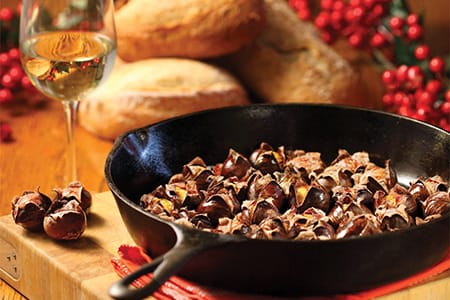This nostalgic nut makes a toasty holiday treat.
Most of us have sung these Christmassy lyrics: “Chestnuts roasting on an open fire….” But some of us may never have tasted a fresh chestnut, roasted or otherwise.
Chestnuts are the edible seed nuts produced by the various species of the chestnut tree (Castanea). The nut is encased in a feathery seed pod that splits when ripe to reveal the shiny nut inside.
Here in the Atlantic Provinces, we are most familiar with something we call horse chestnuts—otherwise known as conkers. (You may be familiar with the game of conkers, which involves threading a horse chestnut onto a string and taking turns striking your opponent’s conker until it breaks.) Horse chestnuts, however, are not actual chestnuts, and it’s important to note that they are not edible.
In early North American history, chestnut trees were prolific and were a staple in Native American diets, but in the early 1900s, some chestnut trees were imported from Asia and planted on Long Island in New York.
Unfortunately, these trees carried a fungus that quickly spread across North America, destroying virtually all of the existing chestnut trees. The native crop never fully recovered. Today, most of the chestnut food crop is imported from Japan, China, Spain, and Italy.

Chestnuts are very popular at Thanksgiving and Christmas, perhaps because they make a wonderful addition to stuffing. The British love their chestnuts, as do Americans, who use them for soups, accompaniments to roast meats and even as desserts. In England, and in parts of the US and Canada, it is not uncommon to find vendors selling packets of freshly roasted chestnuts on the streets during the winter months.
In Atlantic Canada, they are often sold canned. This canned version will work well in most recipes that call for chestnuts, but specialty and import shops may sell whole fresh chestnuts.
Chestnuts work well with both savoury and sweet dishes. They are quite starchy and have a sweet, nutty flavour. They can be eaten raw, but have a warmer and richer flavour when cooked or roasted.
Chestnuts have two skins: the first is a hard outer shiny brown husk; underneath this is a thinner skin. Before cooking, remove the outer skin. Always use a knife to score the inner skin of each chestnut with an “x”—they contain moisture that is released during cooking and will explode if not properly prepared.
A festive way to warm up over the holidays.